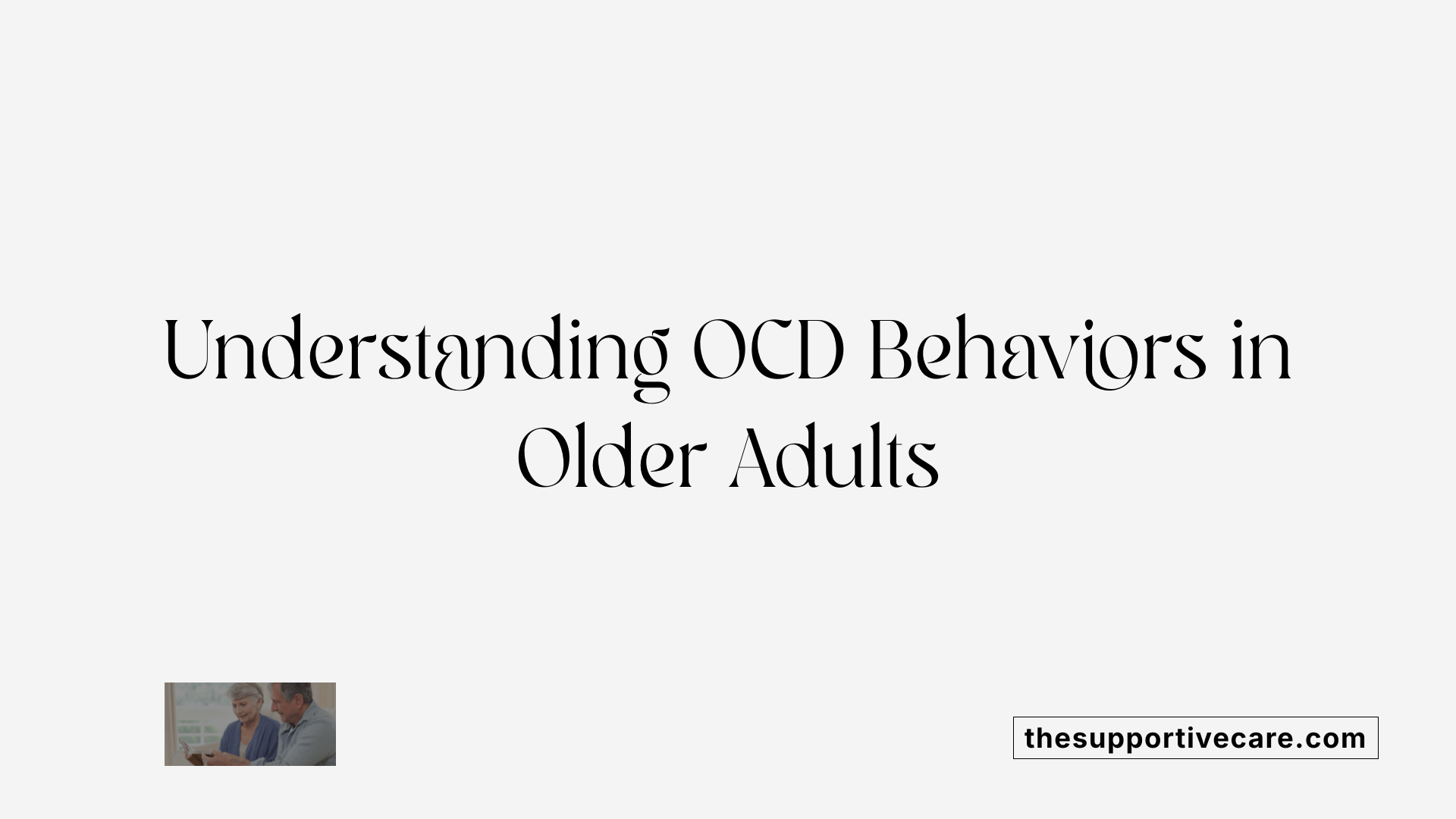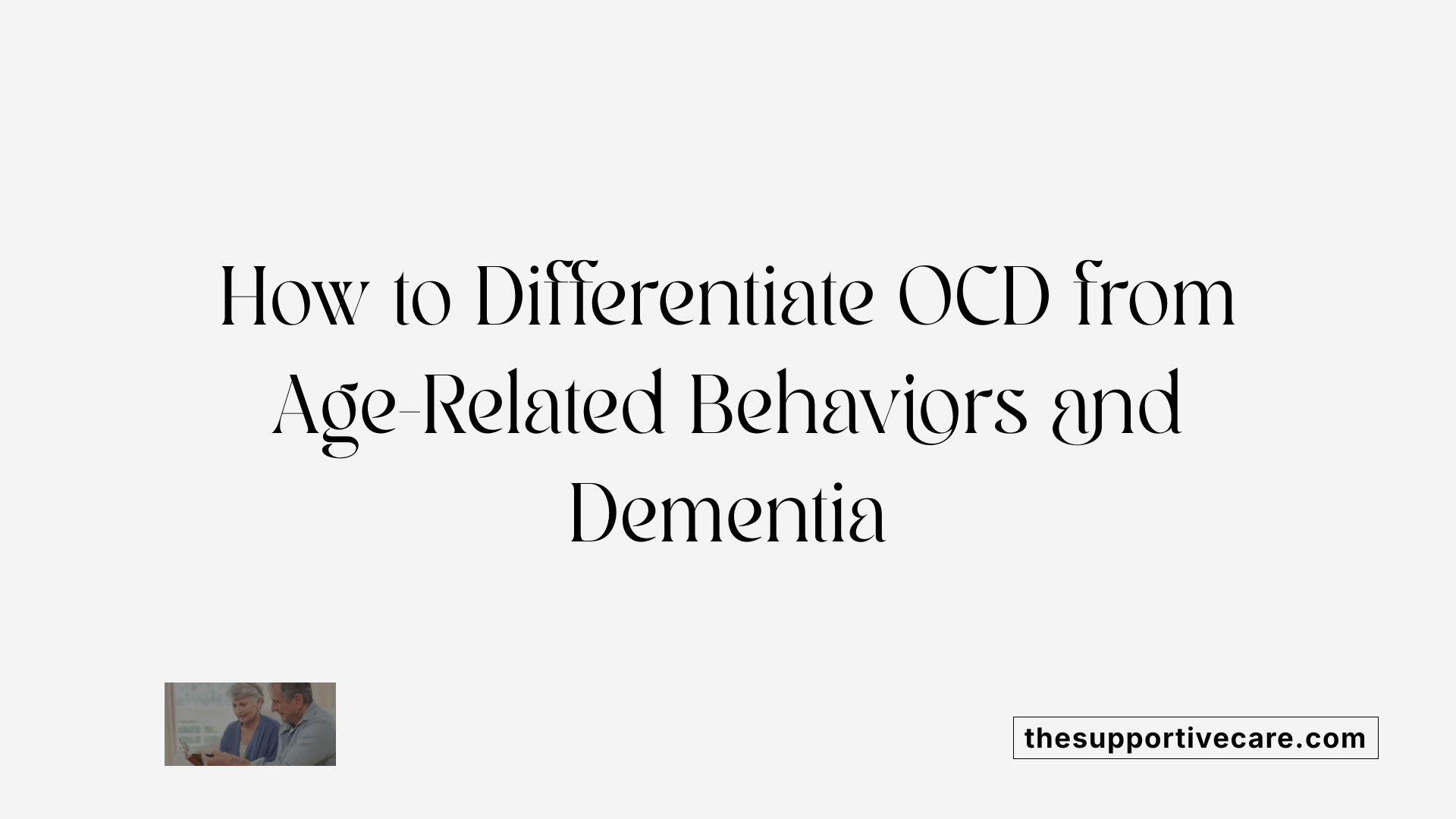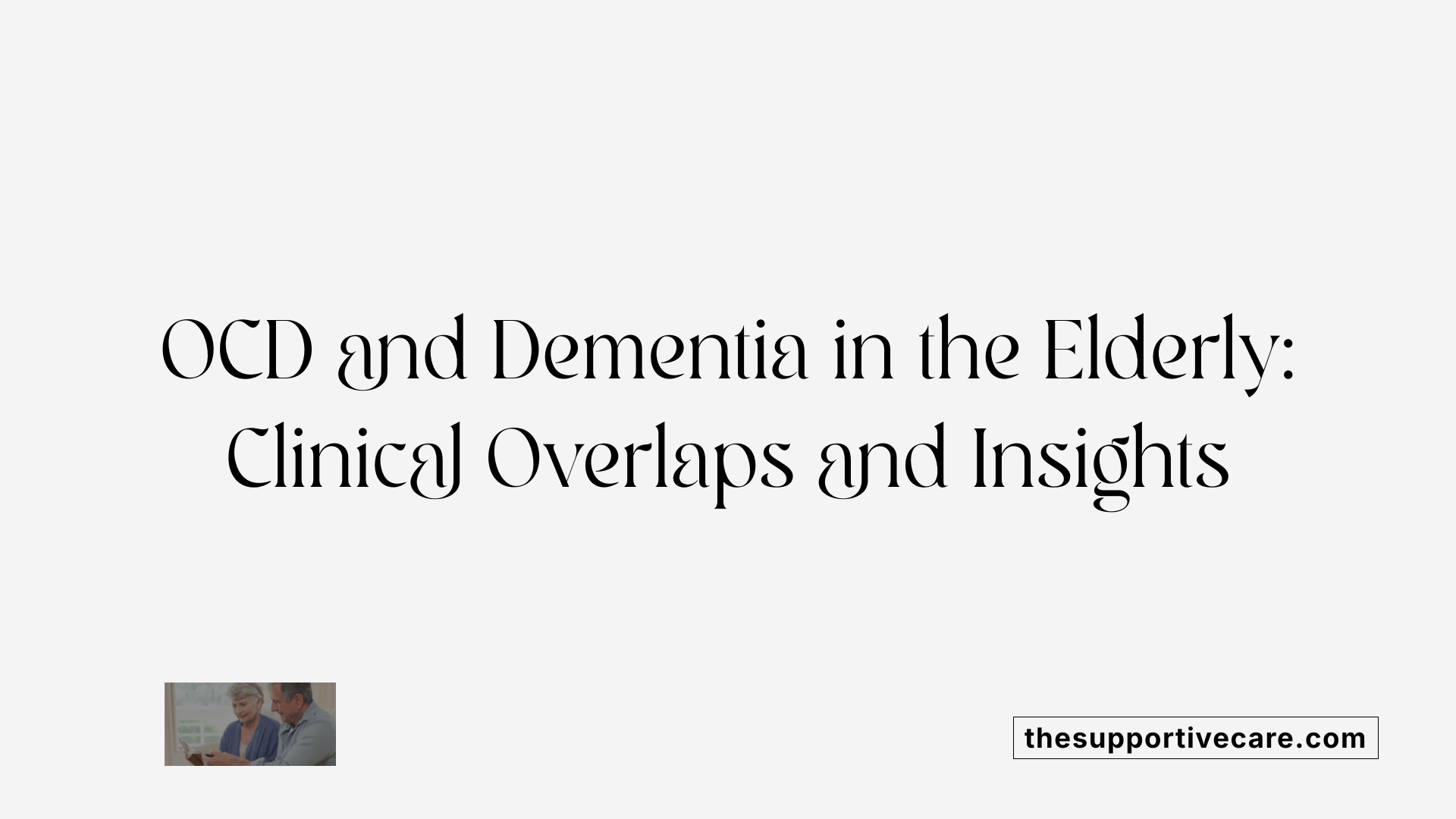Understanding OCD in the Elderly: Key Insights and Recognition Strategies
Recognizing obsessive-compulsive disorder (OCD) symptoms in seniors is crucial for timely diagnosis and effective management. While OCD often begins earlier in life, it can persist or emerge during older age, sometimes overlapping with neurodegenerative conditions like dementia. Differentiating OCD from normal habits and dementia-related behaviors presents challenges but is essential for providing appropriate care. This article explores how OCD manifests in seniors, how to distinguish it from other conditions, and the best approaches for intervention.
Fundamentals of OCD and Its Core Features
What is the hallmark symptom of obsessive-compulsive disorder?
The primary characteristic of obsessive-compulsive disorder (OCD) is the presence of uncontrollable, recurring thoughts known as obsessions. These persistent thoughts are unwanted and often distressing, causing significant anxiety or discomfort. To cope with these obsessions, individuals usually engage in repetitive behaviors or mental acts called compulsions.
Compulsions are performed with the goal of reducing the anxiety triggered by obsessions or preventing feared events, even if these behaviors are irrational or excessive. For example, a person may repeatedly wash their hands to eliminate germs from an obsessive fear of contamination, or check locks repeatedly due to doubts about safety.
These symptoms tend to be time-consuming, often taking up more than an hour each day, and can severely disrupt daily routines, relationships, and overall functioning.
In summary, the core features of OCD are clear: unwanted, persistent thoughts—obsessions—that lead to compulsive actions aimed at alleviating anxiety. Recognizing this pattern is essential for diagnosis and treatment, as these symptoms significantly interfere with an individual’s quality of life.
Recognizing OCD Symptoms in Elderly Populations

What are the common signs and symptoms of obsessive-compulsive disorder (OCD) in the elderly?
In older adults, OCD often presents with specific behaviors and thoughts that can easily be mistaken for normal aging or other health issues. Common signs include persistent fears of contamination, such as worries about germs, dirt, or illness, leading to excessive cleaning or hand-washing that can damage skin. Repeated checking routines—like ensuring that doors are locked, stoves are turned off, or appliances are safe—are also frequent.
Many elderly individuals experience a strong need for order and symmetry. They might spend hours arranging items precisely or repeatedly reordering things to feel safe. Unwanted intrusive thoughts related to harm, morality, or religious themes are common, causing distress and sometimes leading to ritualistic behaviors.
Repetitive compulsions such as washing, counting, or arranging objects are driven by the desire to reduce the anxiety caused by these obsessions. While these rituals might temporarily lessen distress, they can interfere substantially with daily activities.
Stress often worsens OCD symptoms, leading to more frequent or intense rituals. This cycle can diminish the elderly person’s independence, emotional well-being, and social interactions.
Early identification of these signs is crucial. Proper diagnosis enables effective treatment options like cognitive-behavioral therapy, especially exposure and response prevention (ERP), alongside medications such as SSRIs. Understanding these symptoms helps caregivers and healthcare providers support seniors in managing OCD and maintaining quality of life.
Differentiating OCD from Normal Habits and Dementia Behaviors

How can you distinguish OCD symptoms from normal habits or dementia-related behaviors in seniors?
In elderly individuals, understanding whether behaviors are part of obsessive-compulsive disorder (OCD), normal routines, or dementia-related actions is crucial for appropriate management.
OCD involves persistent, unwanted thoughts called obsessions and repetitive actions known as compulsions that cause significant distress and disrupt daily life. These behaviors are typically recognized by the individual as problematic and are driven by specific fears, such as germ contamination or a need for order.
In contrast, normal habits are habits performed almost automatically without causing stress or interfering with daily functioning. For example, locking a door multiple times might sometimes be a habit rather than a compulsive act if it is done without anxiety or distress.
Dementia-related behaviors can include repetitive actions as well, but these often stem from memory lapses, confusion, or cognitive decline. For instance, an individual with dementia might repeatedly check the stove out of forgetfulness rather than an underlying obsession. These behaviors tend to occur alongside other cognitive issues like forgetfulness, disorientation, or difficulty communicating.
The timing of onset provides additional clues. Most cases of OCD develop earlier in life but can sometimes occur or reemerge in later years. When new obsessive or compulsive behaviors develop in seniors who previously did not have such symptoms, it may indicate an underlying neurodegenerative process like dementia.
Neuroimaging studies and clinical assessments are valuable tools for differentiation. Brain scans of dementia patients often show structural changes or atrophy in regions such as the frontal or temporal lobes. Conversely, primary OCD is frequently associated with hyperactivity in the orbitofrontal cortex and related circuits.
Recognizing these differences allows clinicians to tailor treatments effectively. OCD is often managed with behavioral therapies, such as exposure and response prevention, as well as medications like antidepressants. Dementia management focuses on cognitive support, routines, and possibly medications to slow decline.
In summary, differentiating OCD from habits and dementia behaviors involves careful assessment of the symptoms’ nature, context, and underlying brain changes, enabling appropriate intervention and improved quality of life for elderly individuals.
Assessment Tools and Diagnostic Approaches
Use of OCI-R in elderly
The Obsessive-Compulsive Inventory-Revised (OCI-R) is an established tool for assessing OCD symptoms in older adults. Research has demonstrated that OCI-R has strong reliability and validity within this age group, making it a valuable screening instrument. It encompasses six symptom domains: Washing, Checking, Ordering, Obsessing, Hoarding, and Neutralizing. The OCI-R's ability to detect specific symptom patterns, including hoarding behaviors common among seniors, supports its use for both initial screening and ongoing monitoring.
Screening and diagnostic measures
Effective diagnosis of OCD in the elderly often combines self-report scales like the OCI-R with comprehensive clinical interviews. The Structured Clinical Interview for DSM-5 (SCID) is a gold-standard diagnostic tool that allows clinicians to assess the severity and impact of symptoms. It's essential to evaluate the duration, frequency, and distress caused by symptoms, as well as their interference with daily functioning. Combining quantitative assessments with qualitative data from interviews ensures an accurate diagnosis.
Importance of clinical interview and collateral information
In elderly patients, clinical interviews are crucial because some symptoms may be masked or confused with early signs of dementia or anxiety disorders. Gathering collateral information from family members or caregivers helps verify the presence, frequency, and context of compulsive behaviors. This information can clarify whether behaviors like repeated checking or cleaning are problematic rituals or normal age-related routines. Incorporating caregiver insights enhances diagnostic accuracy, especially when the patient has cognitive impairments.
Identifying specific symptom domains
Recognizing the particular themes of obsessions, such as health fears, contamination, moral scrupulosity, or symmetry needs, guides tailored treatment approaches. In seniors, symptom domains like hoarding or excessive religiosity are also prevalent. A detailed assessment of these specific areas helps determine whether symptoms are part of primary OCD or secondary to other conditions like dementia. Understanding the particular domains influences therapy strategies and aids in distinguishing OCD from organic mental health issues.
Treatment and Management Strategies
What are the treatment options and management strategies for OCD in seniors?
Managing OCD in elderly adults requires a comprehensive approach that considers the unique challenges of aging. The primary treatments include psychotherapy, medications, lifestyle modifications, and support from caregivers.
Psychotherapy options such as Cognitive-Behavioral Therapy (CBT), especially exposure and response prevention (ERP), are highly effective for seniors. These therapies are tailored to the individual's cognitive abilities and physical health, helping them recognize their obsessions and learn healthier responses. Simplifying routines, organizing living spaces, and encouraging consistent daily habits can also reduce environmental triggers and anxiety.
Medication considerations are crucial when treating older adults. Selective Serotonin Reuptake Inhibitors (SSRIs) like fluoxetine, sertraline, and fluvoxamine are commonly prescribed. However, at lower doses, due to slower metabolism and increased sensitivity in seniors, close monitoring for side effects such as gastrointestinal issues, sleep disturbances, or interactions with other medications is necessary.
Addressing co-occurring conditions, such as depression or early signs of cognitive decline (like dementia), is vital for effective treatment. Differentiating OCD from symptoms of dementia is important, as treatments may differ. For example, in dementia-related obsessive behaviors, management focuses more on reducing anxiety and maintaining safety.
Lifestyle modifications include stress reduction techniques like mindfulness, deep breathing exercises, and relaxation therapies. Supportive interventions such as engaging in physical activities, maintaining social connections, and establishing predictable routines can help manage anxiety related to OCD.
Caregivers and family members play a vital role in supporting seniors. They can assist in maintaining medication routines, encouraging participation in therapy sessions, and creating a calming environment at home. Educating caregivers about OCD symptoms can improve their ability to provide reassurance and prevent the reinforcement of compulsive behaviors.
Emerging treatments like transcranial magnetic stimulation (TMS) or deep brain stimulation (DBS) may be considered in severe cases unresponsive to traditional approaches.
In summary, effective management of OCD in elderly adults combines psychological therapies, judicious medication use, lifestyle changes, and strong caregiver support. Regular assessment and personalized treatment plans are crucial to enhancing quality of life for seniors living with OCD.
The Overlap Between OCD and Dementia and Its Clinical Implications

Are OCD symptoms in the elderly linked to other cognitive conditions such as dementia?
There is growing evidence indicating a possible connection between obsessive-compulsive disorder (OCD) symptoms and certain cognitive decline conditions like frontotemporal dementia (FTD) in older adults. Many elderly individuals exhibiting obsessive behaviors, such as hoarding or repetitive actions, may present symptoms that resemble those of dementia.
In dementia, particularly FTD, behaviors tend to be impulsive or disinhibited rather than driven by obsessive fears. This distinction is important because while OCD compulsions are performed to reduce anxiety caused by persistent thoughts, behaviors in dementia often lack this anxious component and stem from loss of self-control.
Neuroimaging studies reveal similar dysfunctions in brain areas such as the frontal and temporal lobes. These regions are critical for planning, judgment, and behavioral regulation. Both OCD and dementia show atrophy or abnormal activity in these circuits, hinting at shared neural pathways.
Importantly, some research reports that OCD symptoms can appear years before a formal dementia diagnosis, suggesting they might act as early indicators of neurodegeneration. This temporal relationship points to the potential of OCD behaviors serving as warning signs, especially when they are new or worsening.
However, the relationship between OCD and dementia is complex. In some cases, obsessive behaviors in older adults could be from primary psychiatric disorders, while in others, they reflect neurodegenerative processes. Proper assessment and differential diagnosis are crucial to distinguish whether these symptoms are benign routines, primary OCD, or early signs of dementia.
Clinicians should consider the onset, nature, and context of obsessive behaviors and incorporate neuropsychological testing and imaging to guide diagnosis. Recognizing this overlap ensures timely intervention, which can improve quality of life and help manage progression of underlying cognitive decline.
Early Recognition and Comprehensive Care for Better Outcomes
Recognizing OCD symptoms in seniors involves an understanding of typical presentation, differentiation from normal and dementia-related behaviors, and awareness of effective diagnostic tools. Early identification allows for targeted interventions, which include psychotherapy, medication, and supportive environment modifications. Collaboration among healthcare providers, caregivers, and patients is vital to manage symptoms effectively and improve quality of life. Continued research and education are needed to deepen our understanding of OCD in the aging population, helping to develop tailored treatment strategies that address the unique challenges faced by seniors.
References
- Dementia and OCD: Obsessive Compulsive Disorder in Elderly Adults
- Obsessive-Compulsive Disorder in Elders - AgingCare.com
- Obsessive and compulsive symptoms in elderly: A litterature review
- OCD (Obsessive-Compulsive Disorder): Symptoms & Treatment
- Obsessive-compulsive disorder (OCD) - Symptoms and causes
- How OCD Can Manifest in Dementia
- OCD in Elderly for Caregivers
- A Guide to Understanding OCD: Symptoms, Myths, and Treatment



































































































